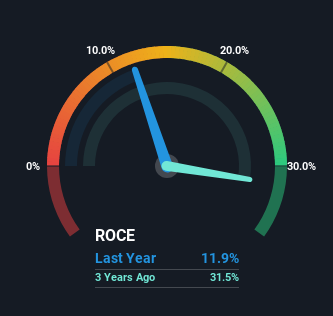There are a few key trends to look for if we want to identify the next multi-bagger. Typically, we’ll want to notice a trend of growing return on capital employed (ROCE) and alongside that, an expanding base of capital employed. Basically this means that a company has profitable initiatives that it can continue to reinvest in, which is a trait of a compounding machine. However, after briefly looking over the numbers, we don’t think Wetouch Technology (NASDAQ:WETH) has the makings of a multi-bagger going forward, but let’s have a look at why that may be.
Return On Capital Employed (ROCE): What Is It?
If you haven’t worked with ROCE before, it measures the ‘return’ (pre-tax profit) a company generates from capital employed in its business. To calculate this metric for Wetouch Technology, this is the formula:
Return on Capital Employed = Earnings Before Interest and Tax (EBIT) ÷ (Total Assets – Current Liabilities)
0.12 = US$13m ÷ (US$119m – US$7.3m) (Based on the trailing twelve months to September 2023).
So, Wetouch Technology has an ROCE of 12%. In absolute terms, that’s a pretty normal return, and it’s somewhat close to the Electronic industry average of 11%.
Check out our latest analysis for Wetouch Technology

While the past is not representative of the future, it can be helpful to know how a company has performed historically, which is why we have this chart above. If you want to delve into the historical earnings , check out these free graphs detailing revenue and cash flow performance of Wetouch Technology.
How Are Returns Trending?
We weren’t thrilled with the trend because Wetouch Technology’s ROCE has reduced by 79% over the last four years, while the business employed 285% more capital. Usually this isn’t ideal, but given Wetouch Technology conducted a capital raising before their most recent earnings announcement, that would’ve likely contributed, at least partially, to the increased capital employed figure. Wetouch Technology probably hasn’t received a full year of earnings yet from the new funds it raised, so these figures should be taken with a grain of salt. It’s also worth noting the company’s latest EBIT figure is within 10% of the previous year, so it’s fair to assign the ROCE drop largely to the capital raise.
On a side note, Wetouch Technology has done well to pay down its current liabilities to 6.1% of total assets. That could partly explain why the ROCE has dropped. Effectively this means their suppliers or short-term creditors are funding less of the business, which reduces some elements of risk. Some would claim this reduces the business’ efficiency at generating ROCE since it is now funding more of the operations with its own money.
What We Can Learn From Wetouch Technology’s ROCE
Bringing it all together, while we’re somewhat encouraged by Wetouch Technology’s reinvestment in its own business, we’re aware that returns are shrinking. Moreover, since the stock has crumbled 97% over the last three years, it appears investors are expecting the worst. On the whole, we aren’t too inspired by the underlying trends and we think there may be better chances of finding a multi-bagger elsewhere.
One more thing: We’ve identified 4 warning signs with Wetouch Technology (at least 3 which are a bit unpleasant) , and understanding them would certainly be useful.
While Wetouch Technology may not currently earn the highest returns, we’ve compiled a list of companies that currently earn more than 25% return on equity. Check out this free list here.
Valuation is complex, but we’re helping make it simple.
Find out whether Wetouch Technology is potentially over or undervalued by checking out our comprehensive analysis, which includes fair value estimates, risks and warnings, dividends, insider transactions and financial health.
View the Free Analysis
Have feedback on this article? Concerned about the content? Get in touch with us directly. Alternatively, email editorial-team (at) simplywallst.com.
This article by Simply Wall St is general in nature. We provide commentary based on historical data and analyst forecasts only using an unbiased methodology and our articles are not intended to be financial advice. It does not constitute a recommendation to buy or sell any stock, and does not take account of your objectives, or your financial situation. We aim to bring you long-term focused analysis driven by fundamental data. Note that our analysis may not factor in the latest price-sensitive company announcements or qualitative material. Simply Wall St has no position in any stocks mentioned.
